This is the second part of a series of three posts dealing with the mechanism of creation from the point of view of science. These will be followed by a series of posts addressing questions and concerns that Christians might have about this scientific view.
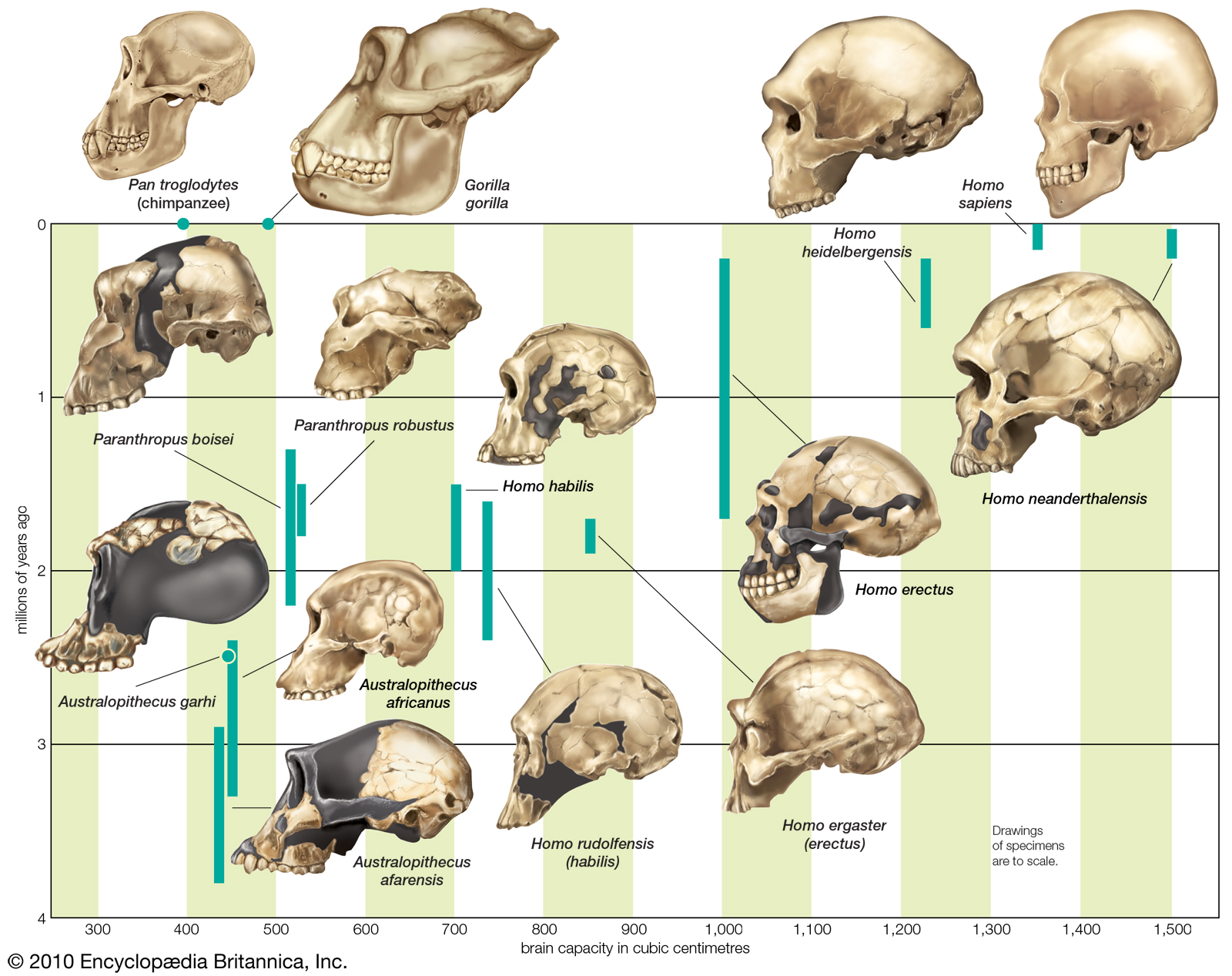
In my previous post, I pointed out that evolution is a loaded word that has multiple meanings for people and that part of the conflict between Christianity and science in this area is due to misunderstandings about the meanings of the word. There are four basic meanings relevant to our discussion:
- change over time
- common descent
- a mechanism (natural selection)
- a justification for atheism.
The first three meanings are scientific conclusions while the fourth is a metaphysical interpretation of the scientific findings which I will talk about later in this series. In today’s post we’re going to consider the second scientific meaning of evolution, common descent.
Common descent, also known as descent with modification, is the idea that all living things including humans have descended through modification over time from a common ancestor. The most distant ancestor of all living things is believed to be a single cell organism, much like a bacteria, that lived more than 3 billion years ago.
I’m going to talk about four types of evidence which support the idea of common descent. They are
- the common cellular and molecular basis of life
- family relationships among living organisms
- transition forms in the traditional fossil record
- genetic fossils present in living organisms.

Common Cellular and Molecular Basis of Life. All organisms are made up of cells which serve as the basic building blocks of life. Additionally, all cells use the same basic molecules of life (see Fig. 1). Genes carry the information that is necessary for the normal functioning of all cells and are the basis of inheritance in all organisms. The chemical nature of genes is the same in all organisms. DNA, the molecule that carries genetic information, is a polymer made up of four types of nucleotide building blocks abbreviated as A, C, G and T. The information is carried through a genetic code by the order of the DNA building blocks in the polymer chain.
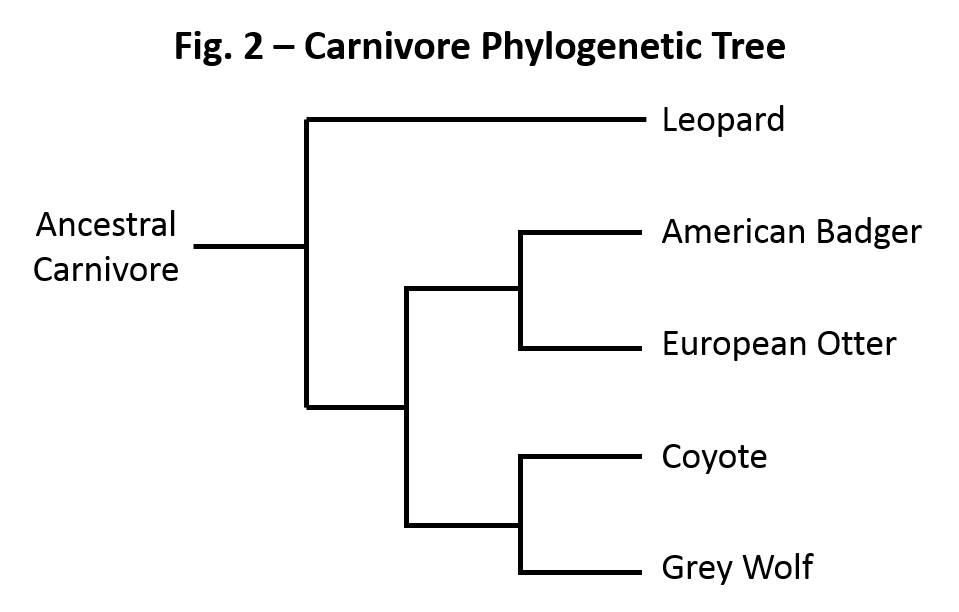
Family Relationships among Living Organisms. The 18th century Swedish botanist Carolus Linnaeus developed a nested classification system for living things based on their anatomical similarities and differences. This system is still used today. In this system, species are grouped into increasingly general categories. For example, similar species are grouped into a genus and similar genera are grouped into families and so on. Based on these hierarchical anatomical relationships, one can construct a type of family tree called a phylogenetic tree. Figure 2 provides an example of such a tree showing the family relationships among carnivores (meat eating animals).
Transition Forms in the Traditional Fossil Record. As I mentioned in my last post, fossils are formed from the remains of dead animals and plants. Fossils in the geological layers (strata) provide a record of the history of life with the uppermost layers being most recent and deeper layers revealing progressively more ancient history.
In his book, Finding Darwin’s God: A Scientist’s Search for Common Ground between God and Evolution, Ken Miller says, “Just as human history reveals a succession of languages, civilizations, and empires, natural history reveals a succession of living organisms that are linked in a stunning pattern of relatedness.”
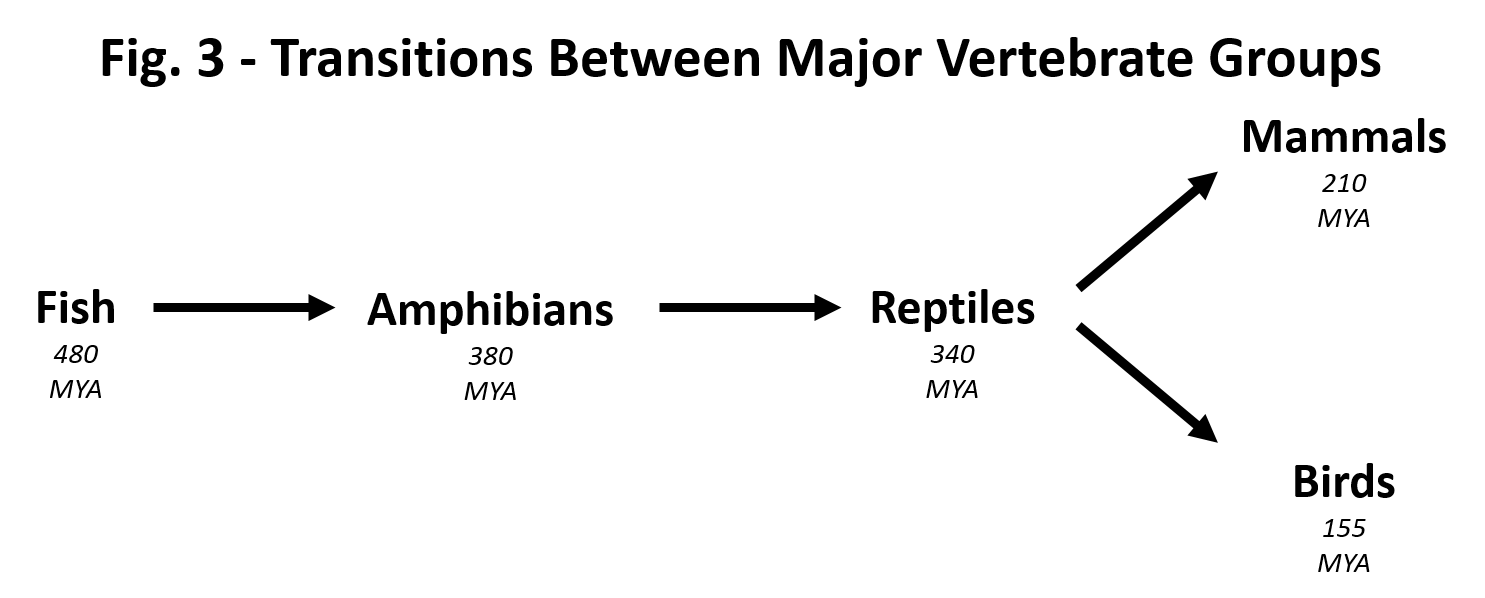
This pattern has been especially well worked out in the major vertebrate groups (Fig. 3). There we see a series of transitions leading from fish to amphibians, from amphibians to reptiles and from reptiles to mammals and birds. In each case there are a series of transition forms in the fossil record that connect the major groups. Ken Miller again, “Within a particular series of transition forms the first members are loaded with characteristics that indicate their ancestry. . . .” For example, “The first amphibians looked more like fish than any amphibian species that would follow them in the next 380 million years.”
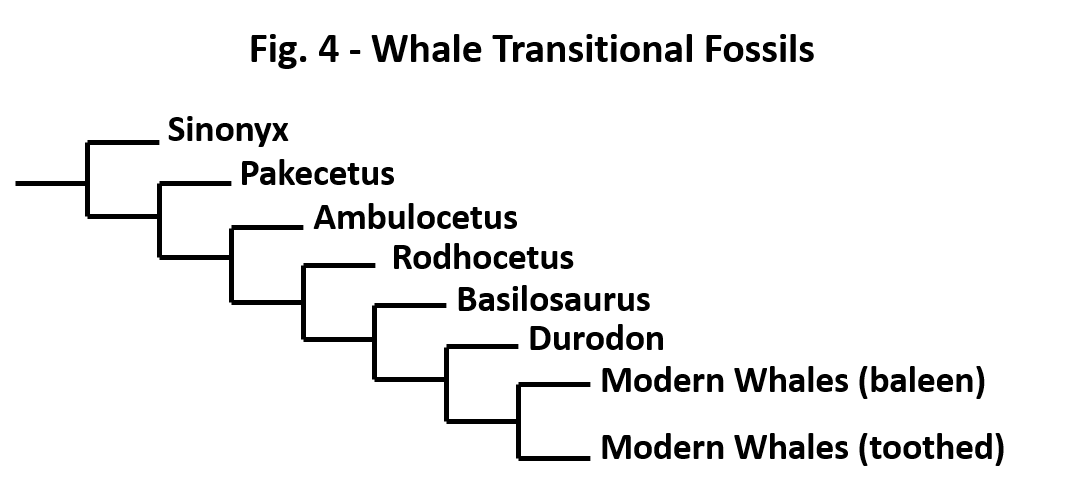
A particularly interesting and well documented example of transition fossils is seen in the evolution of whales (Fig. 4). The series of transitional fossils begins with Sinonyx, a wolf-sized 4-legged land animal that was a predatory scavenger that lived by the sea shore. Over time in the fossil series the front legs became fins, back legs disappeared, there was a loss of fur and transition of the body form to the streamlined shape of modern whales. The fossils also reveal a gradual migration of nostrils to the top of the head, an adaptation which allowed breathing in the water. Here is a link (http://www.youtube.com/watch?v=I2C-3PjNGok) to an excellent video which documents the discovery and evidence for this series of transition fossils.
Genetic Fossils. Surprisingly the genomes of living organisms contain remnants of functional genes (pseudogenes) as well as two types of parasitic DNA (transposons and retroviruses) which provide a window into the history of the living creatures. These genetic fossils can be used as markers to trace the family history of organisms. Let me give you two examples, one involving a pseudogene the second involving a transposon.
Sailors on long ocean voyages used to suffer from a disease called scurvy. The disease is caused by a deficiency in Vitamin C. Humans are not able to make this important vitamin. We share this problem with other primates. In contrast rats and most other mammals are able to make their own vitamin C. The difference is the presence of a gene called gulo which is necessary for the synthesis of Vitamin C. Surprisingly humans and other primates have a remnant (pseudogene) of gulo but it has a single mutation that makes the gene non-functional.
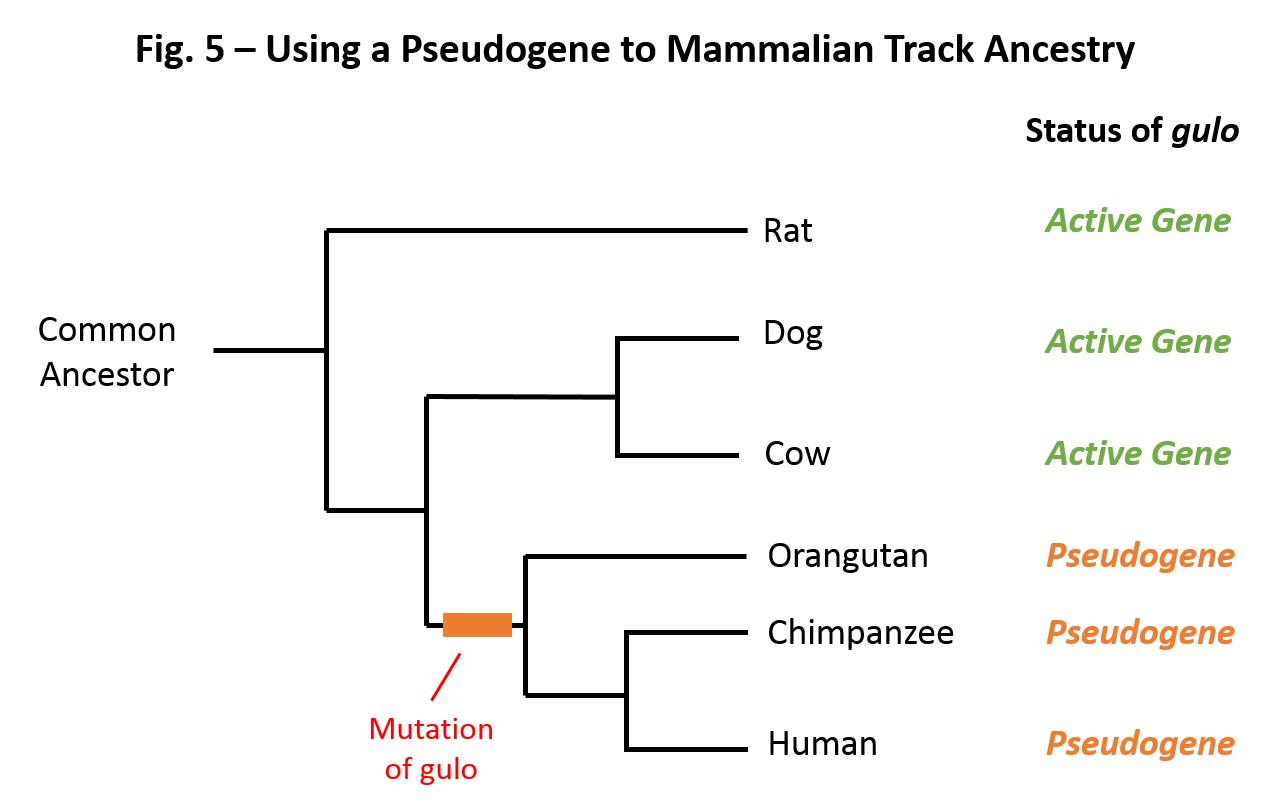
The question is how to explain the presence of this pseudogene in humans and other primates. The simplest explanation is that they are descended from a common ancestor which at some point in the distant past this ancestor developed the mutation in the gulo gene. This mutation was then passed on to all humans and other primates. The fact that rats and other mammals don’t have this pseudogene indicates that the common ancestor of humans and other primates was on an evolutionary branch that diverged from other mammals (Fig. 5).
The second type of genetic fossil we are going to consider are transposons, also known as jumping genes. Most transposons have no known function but are simply parasitic DNA that is reproduced with the rest of the genome during cell division and thus passed on to their ancestors. Amazingly transposable elements account for about ½ of the DNA in the human genome.
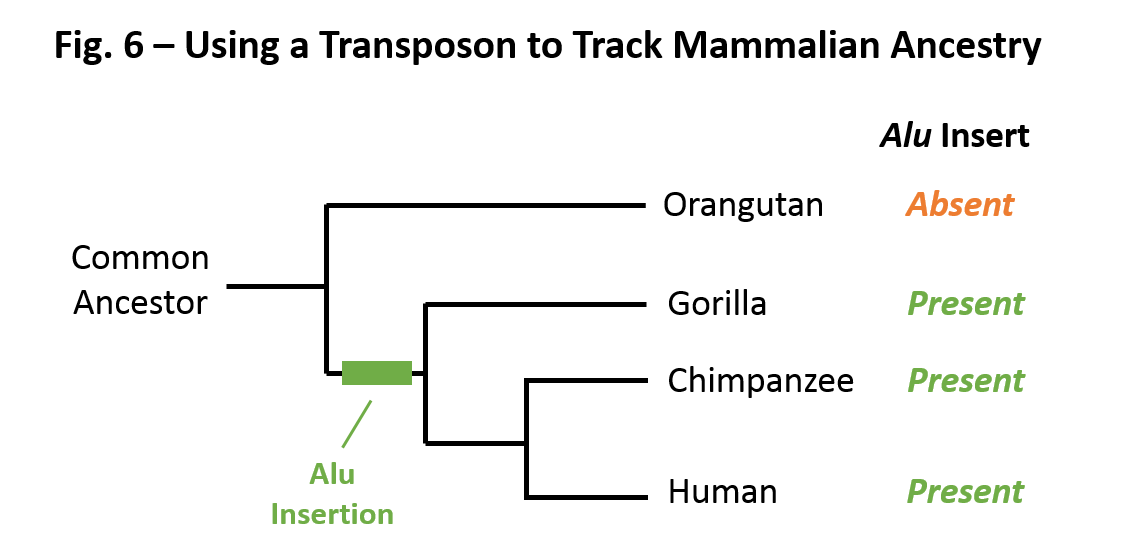
As the name jumping gene implies, transposable elements are able to jump in and out of the genome both within and between chromosomes. Occasionally they become damaged in the process and thus become fixed at a specific location on a chromosome. An example of this is a transposable element called Alu. It is found at the same specific location in gorillas, chimps and humans but not in orangutans. This is strong evidence that gorillas, chimps and humans are descended from a common ancestor which separated from the orangutan line sometime after insertion of Alu at some point in the distant past (Fig. 6).
Conclusions. In this post I have presented four lines of evidence that support the idea that all living creatures are descended from a common ancestor. These are
- the common cellular and molecular basis of life
- family relationships among living organisms
- transition forms in the traditional fossil record
- the use of genetic fossils as markers to trace the family history of organisms.
Looking ahead: The next post will be part 3 of The Mechanism of Creation – The View from Science. We will talk about the third scientific meaning of evolution, natural selection which is the mechanism that explains both the change over time and common descent.
Questions for further reflection:
- What tensions does the idea of common descent raise for you?
- What questions or concerns do you have about the evidence for common descent?
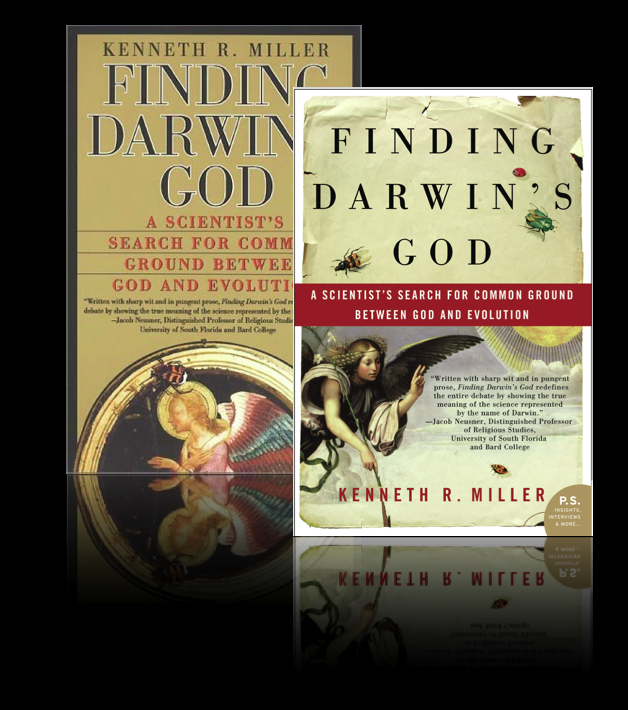
Suggestions for further reading:
- Finding Darwin’s God: A Scientist’s Search for Common Ground between God and Evolution, Kenneth R. Miller. Harper Collins, 2007.
- Creation or Evolution: Do We Have to Choose? Denis Alexander. Monarch, 2008.
- The Language of God: A Scientist Presents Evidence for Belief, Francis S. Collins. Free Press, 2007.
- Coming to Peace with Science: Bridging the Worlds between Faith and Biology, Darrel R. Falk. InterVarsity Press, 2004.
- The Bible, Rocks and Time: Geological Evidence for the Age of the Earth, Davis A. Young and Ralph Stearley. InterVarsity Press, 2008.
- Seminar: Christian Grad Students in Paleobiology (June 21-29, 2014): Through the support of a BioLogos Foundation Grant, Ralph Stearly is co-leading this Calvin College Seminar in Christian Scholarship with Cara Wall-Scheffler (SPU). The due date for the application is February 28.
- Evolution Basics: An Introductory Course on Evolutionary Biology. This is a multipart series from The BioLogos Forum written by BioLogos Fellow Dennis Venema. I particularly recommend the part of the course entitled Genomes as Ancient Texts which discusses genetic fossils in more depth.
- Talk Origins Archive, This Web site contains a collection of articles and essays about evolution. It is not always very Christian friendly but is a good source if you want to delve more deeply into the scientific evidence for evolution.
- Added by the editor: PDF with the titles and links to the posts in Tom Ingebritsen‘s Christianity and Science series. Yes, this was created to meet the requests of readers and will be updated. Your interest in and encouragement of this series is much appreciated.
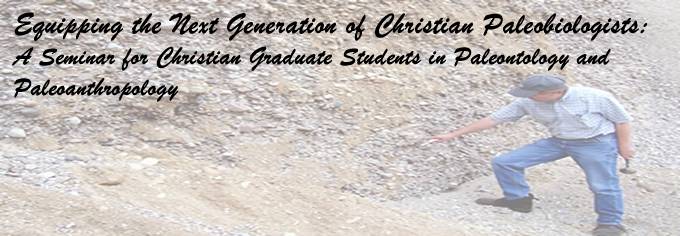
Update: 2/19/2014, 8:18 PM.
Tom Ingebritsen is an Associate Professor Emeritus in the Dept. of Genetics, Development and Cell Biology at Iowa State University. Since retiring from Iowa State in 2010 he has served as a Campus Staff Member with InterVarsity Graduate & Faculty Ministry at Iowa State University

Tom,
Sorry to be posting again, but I just read this piece, and haven’t read the many items you have referred to, and maybe this is covered elsewhere,but I have read that some DNA that was previously considered “junk DNA” has been found to not be junk at all. How does this integrate with your discussion of alu and such?
You might also cover this later but I guess I’d have the basic question, Why do you call this series “The Mechanics of Creation”? Is there anything about the scientific understanding of evolution that points to the existence of a deity? Indeed, IMHO, if evolution is correct, then the apostle Paul is simply wrong to say that God’s existence and power are evident in nature in Romans 1. If we are going to avoid “God of the gaps” assertions, nothing about the cosmos nor anything on earth testifies to the existence of even the god of the Deists, let alone the biblical God, if we are going to be rigorously scientific about origins. We need to take the “Creator God” and put him in a hermetically sealed bubble that doesn’t affect anything we know about the world from a scientific standpoint, don’t we? There seems to me to be a large number of biblical passages that are simply nonsense if humans are the product of evolution,such as Psalm 8, 19, and 139, Romans 1 and 1 Corinthians 15. I can’t speak to the science issues, but I’m trained as an exegete and the dances I’ve read to make these texts “fit” with evolution have to “break” hermeneutical principles that on any other topic would be rejected out of hand, IMHO.
Ken Litwak
Ken,
I don’t have time right now to comment on everything, and I don’t want to steal Tom’s thunder, but it occurred to me that for a conversation on the very salient questions you raise, it would be helpful to know where we are starting from.
To that end — you mention Psalm 19 and Psalm 139. Psalm 19:4b-6 read “In the sky he has pitched a tent for the sun. Like a bridegroom it emerges from its chamber; like a strong man it enjoys running its course. It emerges from the distant horizon, and goes from one end of the sky to the other; nothing can escape its heat.” Psalm 139:13 reads “Certainly you made my mind and heart; you wove me together in my mother’s womb.”
Can you speak to the hermeneutical principles that allow those verses to be reconciles with a sun that is fixed and an earth that goes around it rather than a sun that goes around the earth (for Psalm 19), or with a developmental biology account of how a single cell becomes an infant human by means of gene expression and protein activities.
I’m not trying to be tricky or set you up for a trap. Rather, I think it would be good to know if we all agree on how hermeneutics apply in those situations; if so, then we can proceed from there, and if not then talking about evolution will likely be fruitless because we will really be expressing more fundamental differences.
Hi Andy,
Good questions. There won’t be anything particularly unique about my general answers.
1. Learn all that we can about the cultural/historical/linguistic/religious/philosophical context of a given biblical book. Unfortunately for us, in response to your specific questions about Psalm 19 and Psalm 139, we need to beware of “Mirror reading,” constructing the original audience(s) for the book of Psalms by reading the individual psalms.
We can speak to the general theological perspective one sees in the Hebrew Bible, however. The Israelites were, or were supposed to be, monotheists. They believed that the one true God, YHWH (vowels uncertain), was more powerful than anything else. They believed that God was responsible for the cosmos. He was also responsible for the earth and al the plants and animals on it, as well as humans. They believed that God was worthy of praise, deserved thanksgiving for his gifts to humanity, and would listen to and grant requests made in prayer. They also believed that humans do evil. Some of this evil could be forgiven under the sacrificial system of the tabernacle (and later temple), although sins done with a “high hand” seem to have been outside this sphere–they could not be atoned for. In many ways, the Israelite laws were similar to their neighbors, but in other ways were very different. They believed that God held humans responsible for their actions, and that one day all would be called to account for how they lived.
2. We need to try to establish genre. Determining the genres of the books of the OT can be difficult, and unlike NT writings, did not have texts that explained genres (e.g., nothing like Lucian’s How to Write History). That said, the book of Psalms appears to contain praise, thanksgiving, and requests. Some psalms celebrate what God has done, which is why he is worthy of praise (100, 104), while others pour out bitter complaints (18, 55). Most the latter, “Lament” psalms end with an expression of confidence in God’s faithfulness (except for Psalm 88). The psalms are full of imagery and are poetic in structure. So when the psalmist speaks of God my rock, he does not mean that God is literally a rock, nor a fortress, nor any of several metaphors used in the book of Psalms. How much of Psalm 19 is the psalmist exercising poetic license and how much it reflects his actual beliefs about the world is unknown. Yet, it seems to me that the bridegroom language is obviously figurative. The psalmist is neither affirming that the Sun actually has a tent to sleep in, nor is he likely to have held to Newtonian physics.
I have thought long about Psalm 139. While the psalmist probably knows nothing about genes or DNA, he doe affirm that God is involved in human development and knows us all even at conception. That’s not a very remarkable idea. Anyone who believes that God exists outside of time can easily conceive of God seeing people before they actually came into existence, or, on a Molinist view, creating a world in which persons would come out of the womb as they do, or in strong predestinarian theology, every9one was decreed to be as they are at conception or after conception but before birth. We do need to remember that, without modern doctors, people were well aware of what a human looks like not many weeks after conception, as they would have seen babies who died in the womb or died shortly after being born because of bad mutations.
It might well be that the psalmist in Psalm 139 thinks that God does put together each individual human, since they know that intercourse leads to pregnancy, and knew that sperm from a male type human was needed for a women to become pregnant but as your question implies, they did not know about cells or how they divided, multiplied, and morphed into human-looking humans. On the other hand, I prefer to think that the psalmist does not in fact credit God with every mutation that occurs in the womb. I would hope that he did not give God credit for conditions such as the internal organs being outside the abdominal cavity, or babies born with no arms or legs. For me that raises serious theological problems, and it is the one place where believing that humans are essentially mutant offspring of some other species would be desirable. Either way, we can see the psalmists making general statements about God’s activity using a lot of imagery, lots of metaphor and simile. That is my genre analysis of the book of Psalms.
After these two elements, we can turn to linguistic information in order to seek to determine the meaning of sentences, clauses, and words (which are dependent upon the meaning of sentences). Linguistics isn’t my specialty but I do think we can readily admit to Hebrew words, like other words, having one or more semantic domains that limit the possibilities for what words might mean. Meaning has to be established at the sentence or paragraph level.
Beyond these things, reading ancient interpreters can be useful, though care needs to be exercised.
Those are basic factors in how I approach exegesis of the biblical text. Does this help you understand how I am interpreting these texts? The psalmists might have held views about the cosmos or the development of life in the womb that turn out to be inaccurate, or they might simply be writing poetry to express a general idea. I think, however, the general idea of Psalm 19 is fairly clear. God is responsible for how the cosmos is and it testifies to him. However, the science I learned in a college astronomy course would suggest that we could rewrite Psalm 19 to say, “The heavens demonstrate what happened to the debris from the Big Bang, nothing more, nothing less.”
Ken
Ken,
Thanks for the detailed treatment of your exegetical approach. I obviously can’t speak for anyone else, but that all works for me as a place to start.
You’ve referenced a number of passages from the Bible which cover a lot of ground, but your primary concern seems to be the one expressed in the conclusion of your comment, so I will speak to that one first and we’ll see where that takes us.
“I think, however, the general idea of Psalm 19 is fairly clear. God is responsible for how the cosmos is and it testifies to him. However, the science I learned in a college astronomy course would suggest that we could rewrite Psalm 19 to say, ‘The heavens demonstrate what happened to the debris from the Big Bang, nothing more, nothing less.'”
I would agree with your summary of Psalm 19. However, I would phrase the current state of astronomy/cosmology slightly differently. “When we study the heavens with the tools of science, we learn about things like gravity and the Big Bang.”
The point being that the tools of science do not find evidence of God because they are not equipped to find evidence of God. That does not imply that there is no evidence of God in the heavens. It is simply a recognition that it is not in the nature of science to find such evidence.
Back when TV was a thing broadcast as an analog signal, you could buy a radio that received not just AM/FM radio signals, but also the audio part of TV signals; it did not process the video portion nor have screen on which to display it. Now imagine that were your only means of receiving TV signals — you would claim there was no evidence of moving pictures associated with the audio you enjoyed. But in reality you just lack the right tools to detect them.
Similarly, science is not equipped to detect every possibly truth; in particular, it cannot detect the supernatural. So when it fails to find evidence of the supernatural, that is really just a statement about science rather than the truth of the universe.
So what do we make of scientists who claim that cosmology or biology eliminate the need for belief in God, or prove that there is no God? What they really seem to be asserting, as I hear it, is that science is the only way to know truth about the universe, or that the only truths that we can know (the only truths that exist, perhaps) are the ones that science can measure. That is certainly one possibility, but it is not the only understanding of truth and not one that is universally agreed upon, even among scientists. (A really interesting question is whether the assertion that the only truths are scientific truths is itself a truth that science can measure or verify.)
Does the fact that there are people, scientists and otherwise, who believe that only scientific truths are valid, ignoring whatever other testimony the heavens provide, offer a contradiction to the passages you cite? I don’t believe so, because elsewhere in the Bible we are told that not everyone will accept the testimony offered to them. This would seem to be the message of Matthew 13, for example (“Although they see they do not see”) or Luke 16 (“If they do not respond to Moses and the prophets, they will not be convinced even if someone rises from the dead.”)
Finally, I want to make clear that even though I am saying that there are certain kinds of truths that science cannot measure, I don’t think that science and religion address separate or separable domains (or magisteria). I think it is absolutely the case both attempt to answer at least some of the same questions. Where they differ is the nature of the answers they offer. When it comes to the stars, the Bible says they are God’s handiwork and science says that handiwork is accomplished by gravity, fusion, etc. For individual human development, the Bible says God knits us in our mothers’ wombs, and science says that is accomplished via tightly regulated & coordinated gene expression. For the human race as a whole, the Bible says God created us in His image, and science says that was accomplished via a variety of processes including diversification via mutation and adaptation via natural selection (more on these in Tom’s next post). To me there is no difference between the first of these two examples, and the third.
Ken-
Thanks for your thoughtful response. I understand your concerns about the compatibility of evolution with belief in God as the creator. I became a Christian in the middle of my career as a Biology professor at Iowa State University and struggled with that question. As a result of that struggle, God gave me the opportunity to develop an honors course at Iowa State called Christianity and Science. That course is the basis for this blog series. As a result of my journey in developing and teaching the course I now believe that evolution is perfectly compatible with belief that God is the creator, that he is sovereign over his creation and that man is the pinnacle of his creation. As I move forward in the series I’m going to explain why I think that is true.
With regard to your question about exegesis, I’ve already addressed some of the issues in my earlier blogs in this series. My first blog was about dealing with tensions between science and the Bible, my third blog talked about the need to read Genesis 1 in its ancient Near-eastern context rather than in the context of modern science and my fifth blog talked about exegetical problems with a “literal” interpretation of Genesis 1. I would appreciate your thoughts about those blogs.
Finally you mentioned the recent controversy about “junk DNA”. One type of evidence indicates that only about 5% of the human genome is necessary for human function while the other 95% is thought to be non-functional “junk DNA”. However, recently results from the ENCODE project have suggested that 80% of the human genome is functional thus raising the question of whether “junk DNA” is really non-functional. The answers seems to be that it depends on what you mean by function.
Let me illustrate this with the case of transposons. I mentioned in this blog that transposons are a type of parasitic DNA in the human genome. Transposons are functional in that they are able to jump in and out of the genome both within and between chromosomes. Thus the ENCODE project would consider transposon DNA to be functional even though it is not generally beneficial to humans. Transposons represent about 50% of human genome DNA and thus account for a significant fraction of the “junk DNA”. If you would like to read more about this subject, I recommend two excellent blogs by Dennis Venema at the BioLogos Forum entitled: Encode and “Junk DNA”, Part 1: All Good Concepts are Fuzzy and Part 2: Function: What’s in a Word?
Tom Ingebritsen
Hi Tom,
I wasn’t sure whether I should reply to your reply or wait for later blog posts. I did go back and found a couple of posts by you related to Genesis 1, and now I’ve read all three parts of your three-part series on the mechanics of creation. I do want to raise a few items, which you may be planning to address in future blog posts. In that case, I would understand if you ask me to wait until a later post.
1. Yes, there are good reasons to not see Genesis 1 as literal. However, if it is not literal, are there any assertions that correspond to truth? If it’s not literal, then being made in God’s image means something else. The seventh day as a rest day for God, which is used by Moses to give a reason for the Sabbath laws is tricky too. I’m not sure what to do with that.
It is also true that Genesis 1(-50) was written in an ANE context. However, there are two challenges there. First, we don’t know what other peoples thought about their own creation stories. Peter Enns thinks those stories are mythical and Genesis 1 joins them. I’ve read some of those texts, and none of them say anything about not telling their audiences what happened. My own specialty is Luke-Acts. I have read portions of multiple Hellenistic historiographers and read portions of Bioi, Lives, a Greco-Roman form of biography. These texts tell us what the authors are doing. They tell us how history is supposed to be written and what it is about. I don’t have anything like that for Genesis 1 or Enuna Elish, So I don’t know, and in principle I think that no one can know with certainty what the genre of such texts is, and without knowing the genre, we can’t really say how to interpret them. We have to rely on other texts in the Old Testament where the intent seems clearer and compare them.
The other problem it raises is something that you mentioned. What did an Israelite in 900 B.C. believe about the earth and the Sun? I don’t know. I can’t determine just based upon reading poetic literature like the Psalms. By way of comparison, I fairly regularly go to http://www.weather.com to see what time sunrise and sunset take place at on a given day. I’m sure that the people at weather.com do not think that the sun revolves around the earth or that there is actually a time that the sun rises from wherever it spends the time while an observer is in the dark literally. So, if it is okay to talk about sunrise, knowing that we know that the sun does not rise, how do we know what that Israelite actually thought? He might well have thought that the earth rested on pillars or that the sky has a vault. Or, he might be using poetic language that corresponds to what can be observed, whether it is astronomically accurate or not. So I urge caution in stating what they actually thought. Again, there’s no text from the ANE that explains poetic literature like the Psalms and gives instruction on how to read them.
2. On junk DNA, if I grant that much if not most of the DNA in every cell is junk DNA, non-useful to humans, and can’t find a beneficial role for it, then it sounds to me like all humans everywhere are fairly defective. If I wrote a computer program that was full of “junk code,” code that did nothing or did nothing useful that anyone could ascertain, that would be a problem. For humans to be “created” that way hardly sounds like it corresponds to a “very good” creation. I do not want to sound blasphemous certainly, but if we are to credit God for human existence in some sense, he is apparently not very skilled or smart. I stress “apparently” in case there are things going on that we simply don’t know yet or don’t recognize yet.
3. I also see some other things fall when we make the opening chapters of Genesis poetry expresses some set of large concepts. We cannot rely upon the specifics. Just as we cannot take “Let us make a human in our own image” as literal, so we can’t take the statement that God put Adam in the garden to care for it as literal either. Yet every book I’ve ever read on the value of work from a Christian perspective uses that verse in Genesis 2 to claim that all work has dignity, and all work is, in some sense, God’s work. Of course, I’ve always thought that this put too much weight on one verse. So that’s okay.
It also means that talk of being “one flesh” in Genesis 2, which is obviously not literal anyway, doesn’t mean what it might appear to mean. So all that language that looks like it is providing a foundation for marriage must mean something else, though I’m unsure what.
4. Your three-part series of the mechanics of creation leaves me with a question. Your series simply assumes, it seems to me, that the non-scientists among us, including myself, should just believe whatever any scientist says, because I don’t have the knowledge to disagree.
Well, several years ago the Jesus Seminar held a press conference with the Los Angeles County coroner related to the subject of Jesus’ resurrection. She stated that in her experience, dead bodies tend to stay dead. Indeed, all the experimental data there is indicates that no one returns from the dead. So, if I am to believe this seemingly scientific assertion, how can I accept Jesus’ resurrection. The solution for some, such as when I asked Karl Giberson about these sorts of matters, is that Jesus’ resurrection is a matter of faith. So, I should use my brain to understand scientific facts but everything about Christianity is an irrational matter of faith.
To put this differently, what should I as a Christian accept (inerrantly?) that scientists state and what things can I safely ignore? Or, to quote a common expression that I use here quite seriously, you cannot have your cake and eat it too. If scientists say, and apparently many do, that humans are a by-product of evolution and there is no need for any outside force or deity to explain everything about evolution, given enough time, should I believe that? If I do choose to believe that, this does not disprove the existence of a deity, but it does make that deity rather, well, irrelevant.
Sorry, I didn’t intend to write so much. Feel free to address any of these in later blog posts. Thanks for your willingness to dialogue.
Ken
Very nice series, Tom. In my recent IVP book (Mapping the Origins Debate) I point out 7 different definitions of evolution, with an illustration of how failure to distinguish them leads to problems.
Gerald-
I am aware of your excellent book and will be mentioning it in an upcoming blog.
Tom Ingebritsen
Very interesting. Thank you.
However, the Gen. record and the Geol. time record and Enuna elish Babyulonian creation myth record the same thing in the same series (If Heidel’s correct on his reconstruction of Enuna elish. See his study on the Babylonian Genesis, U. of Chicago Press. ). How might that be? We have special revelation (Genesis), natural revelation (geology) and “pagan” revelation. The first two I can understand, but the last? Only as a vestigial memory of creation should Enuna elish correspond with the other two. I have yet to read any evolutionist deal with the concordance of these records. Even young earth creationists ignore these concordances.
I think that the polemic against polytheism, animism, and pagan mythology best accounts for Genesis 1-3, esp. from a missiological standpoint. If this is correct, then the science involved is incidental, at best. And perhaps even irrelevant.
The late Dr. Ralph D. Winter, founder of the U.S. Center for World Mission, on the basis on I John 3:8b, argued that Satan corrupted creation, beginning with the Cambrian explosion. (Junk DNA & disease would be Satan’s doing, not God’s. See “Planetary Events and the Mission of the Church,” etc., in Frontiers in Mission, 4th ed., Wm. Carey Internat’l. U. Press, 2008).
Hopefully, I’ll be able to find your blog again to read your response. I accidentally ran across it while looking for something else; and as a former IVCF chapter president (1963) decided to read it.
Ted-
Thanks for your thoughtful comments about this blog. I want to respond first to your comments about the concordance of special revelation (Genesis) and God’s revelation in nature. I’m not a big fan of the concordance approach to interpretation of Genesis 1. This approach views the text as if modern science is embedded in it and thus seeks to give a modern scientific explanation for details in the text. There are two main problems with this approach.
First, the account of the creation of a vault and the separation of the waters below from the waters above the vault on Day 2 suggests that Genesis 1 has in view an ancient near-eastern understanding of cosmology rather than a modern scientific view (see my blog Does Genesis 1 Teach Modern Science; this is the third blog in my series of blogs about Christianity and Science). The ancient near-eastern view was based on their common experience of the cosmos. We have this same experience if we look at the sky at night. It appears to be a solid dome with the stars embedded in it. This is what is meant by the firmament (sky) referred to on Day 2 of Genesis 1. Sometimes rain comes down from above so there must be water above the dome. The water below represents the seas and oceans and there is land in the midst of the water. Obviously, this understanding is vastly different from the modern scientific view of the cosmos.
Second, the order of events in Genesis 1 doesn’t really match up very well with the order of events revealed in nature:
Story from Genesis 1: Day 1 (the beginning, creation of heaven & earth and of light), Day 2 (creation of the firmament (sky) and separation of the water above from the water below), Day 3 (separation of water and dry land, creation of plants as the first life), Day 4 (creation of sun, moon and stars), Day 5 (creation of fish and birds), Day 6 (creation of land animals and man).
Story from Nature: The beginning (Big Bang), the first stars appear, origin of sun, earth and moon, appearance of water, origin of the first life (single cell bacteria-like organisms), origin of atmosphere and oceans, the first true fish appear, first land plants, land animals gradually appear over time (amphibians, reptiles and mammals) then birds and finally humans.
Some significant differences are:
• The appearance of the first stars soon after the Big Bang in the story from nature, where in Genesis 1 they appear on Day 4 in the middle of the creation account, well after the creation of the earth on Day 1.
• In the story from nature the first living things are single cell bacteria-like organisms which lived in water whereas in the Genesis account land plants created on Day 3 were the first living things.
• In the story from nature birds appear after land animals whereas in the Genesis 1 account birds are created on Day 5 before the creation of land animals on Day 6.
For these reasons, I favor “Accommodation” as the interpretive strategy for Genesis 1. The accommodation approach understands that God adjusts his revelation to the scientific, cultural context and understanding of his original audience. Alister McGrath in his book Science and Religion: A New Introduction sees the accommodation approach as the key to reconciling tensions between science and the Bible. The ancient near-eastern understanding of the cosmos seen in Genesis 1, Day 2 was shared by the Hebrews, ancient Babylonians and ancient Egyptians.
I agree with your point that Genesis 1 is intended, in part, as a polemic against polytheism, animism and pagan mythology. Additionally, regardless of how you view the days of Genesis 1, the main message of Genesis 1 is that God is the creator of all things and that humans are the pinnacle of God’s creation, made in his Image and serving as his vice-regents on earth. This important message resonates throughout the rest of the Bible (for more details see The Message of Genesis 1, the second blog in my Christianity and Science blog series).
Regarding your point about Satan corrupting nature beginning with the Cambrian explosion, there is no evidence from science that the laws of nature have changed during the course of natural history. First, we can observe stars and galaxies that are billions of light years distant from the earth. Because the speed of light is constant, the light from these stars must have originated billions of years ago. So, when observing these stars, we are looking back in time. These ancient stars seem to obey the same laws of nature that are observed today. Second, because of a property of nature called entropy, nature, as a whole, is moving from order to disorder. Some interpret this as an indication of the corruption of nature and yet it is this property that drives most of the chemical reactions important for life. Without entropy there would be no life on earth. So, this property of entropy would appear to be a part of God’s original creation. Third, the molecules of life (carbohydrates, lipids/fats, proteins and DNA) as well as the chemical and biological basis of inheritance are virtually the same for all organisms from single cell bacteria to man.
Tom
Thank you, Tom, for your kind comments.
You are correct that I am unclear commenting on Winter’s views. Specifically, Dr. Winter saw predation entering with the Cambrian explosion. Darwin, too, wondered how survival of the fittest fit with God’s good creation. Winter saw the problem as due to Satan and felt we err to claim natural disasters are “acts of God.”
That being said, I’d like to address issues about my cosmology, which is an interpretation of Genesis, not holy writ itself. When we compare Genesis and Geology, we see in Gen. 1:1, that God creates. Science sees a Big Bang 4.5 billion years ago. Gen. 1:1, we see an amorphous mass, just as does modern cosmology. In Gen. 1:3-5, we see light and darkness; modern cosmology sees sun and moon, which Genesis does not discuss until later. Here there is definite difference in sequence.
In Day 2, atmosphere is implied and there is water. In cosmology we have atmosphere and then water also. Then comes continental land (Pangea) in both cosmology and Genesis. Then comes plant life (for oxygen), then marine life (Cambrian explosion). Birds follow in both Genesis and Geology, but in geology there are also amphibians, reptiles, insects. Then in Gen. come land animals (1:24-25) and in geology, mammals. Lastly, Adam, man in Genesis; “Lucy” in Geology, from which humanity derives.
Progression from simple to complex is seen in both Genesis and Geology: amorphous to ordered, water then land, marine life then land life, and lastly man as apex. This briefly summaries an appendix in my commentary. I acknowledge that the appearance/creation of sun, moon, and stars, and the difference in time distinguish Genesis from geology.
While it is often said that the Jews just borrowed their cosmology from pagan Babylonians, that is simplistic. The differences between Genesis and Enuna Elish, etc., are greater than their similarities. I rather suggest both cosmologies derive from something more primordial.
Furthermore, let me suggest that God both accommodates and concords within Scripture. And sometimes He does neither (cf.Job 38:31, where God asks Job if he can expand Orion’s belt or hold the Pleiades together, neither of which could Job have known until the discovery of the Doppler shift. [This was pointed out to me by Dr.Gene Jones, late instructor of physics at Long Beach City College years ago, and later confirmed in a Q & A session with the director of the Griffith Park Observatory at a lecture on archaeoastronomy at the Bower’s Museum.]) Tis comparable to God informing the prophet of Cyrus I the Great prior to his appearance in history.
Your comment re the constant speed of light is interesting. A search of the Web will show that that constant speed is currently being questioned. It is possibly slowing down. That obviously has as yet unknown implications for both cosmology and Genesis. However, the speed of light is an issue not well handled by young earth creationists.(I see them confusing creation with the Flood’s date, another issue).
As a missiologist, I shall still put my money on Genesis being foremost a polemic against polytheism and idolatry rather than a natural history, even if creation is the beginning of its universal history. Indeed, modern world histories start with cosmology and continue into history, following this same pattern, without acknowledging the source of that pattern.
Again, thank you for your quick, thoughtful and thought provoking reply.
Sincerely,
Ted Proffitt